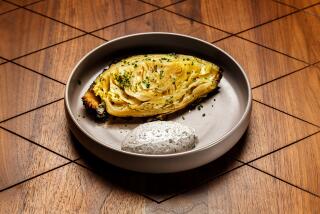For Show or for Salad
- Share via
Some cabbage and kale strains are grown not to be consumed but to be admired. The flowering cabbage shown here is a cool-weather annual that you can find in seedling form at garden centers now. If they’re well grown, the “flowers”--composed of rosettes of curled and crinkled leaves with great substance--spread 10 to 12 inches across. The outer leaves are blue-green; the inner leaves are usually cream or cerise. All have distinctive raised veins that create a marbling effect.
Flowering cabbage and kale are quite similar, although the heads of the cabbage are a bit tighter and flatter than those of kale. Both make excellent winter bedding plants for the front of the flower border or for containers. In Europe, the fresh leaves are used to add color to green salads. In this country, we’re more likely to use the richly textured leaves in floral arrangements.
Flowering cabbage and kale are attractive until warm weather arrives, at which time they “bolt”--that is, the center rises up to form a flower stalk, which is horticulturally interesting but looks rather weedy and may not be considered ornamental.
If you want to try named varieties from seed, order ‘Cherry Sundae,’ a carmine-and-cream flowering cabbage, or ‘Red and White Peacock,’ a prize-winning novelty kale with deeply cut leaves that look like snowflakes. Both are available from Thompson & Morgan, P.O. Box 1308, Jackson, N.J. 08527.
Grow flowering cabbage and kale in good soil in a sunny location. Feed occasionally with a liquid fertilizer. These plants are unusually prone to aphids, so be prepared to spray.






